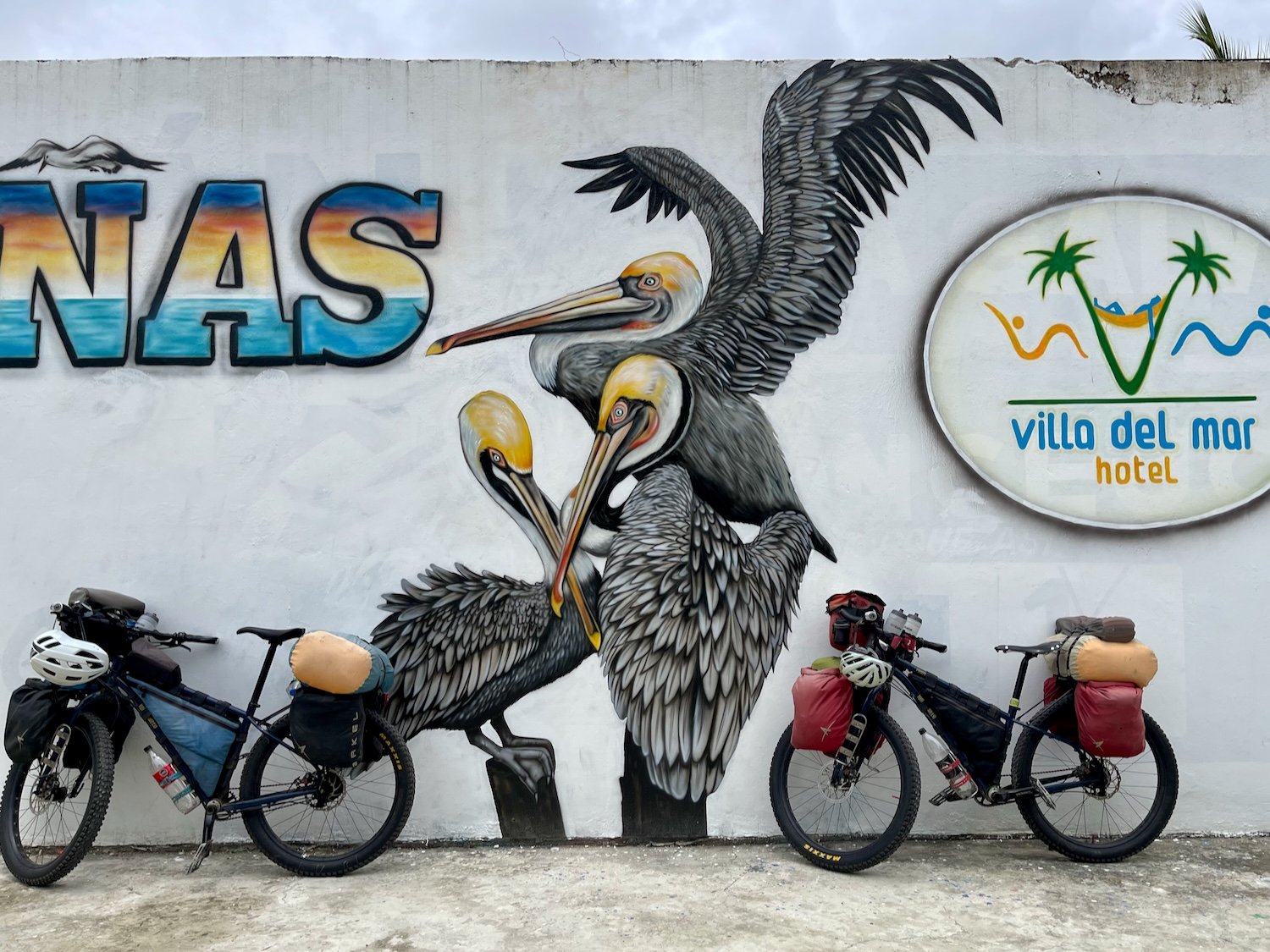Cycling Colombia Part 1: Cartagena to Caucasia
18 April - 6 May 2024
18-24 April - Exploring Cartagena
25 April - Cartagena to Malagana (38.2 mi, 61.5 km)
26 April - Malagana to San Onofre (39.1 mi, 63.0 km)
27 April - Rest day in San Onofre
28 April - San Onofre to Coveñas (33.1 mi, 53.3 km)
29 April - Layover in Coveñas
30 April - Coveñas to Cereté (45.0 mi, 72.4 km)
1 May - Cereté to Montería (10.0 mi, 16.1 km)
2-3 May - Layover in Montería
4 May - Montería to Planeta Rica (35.0 mi, 56.3 km)
5 May - Planeta Rica to Caucasia (41.5 mi, 66.8 km)
6 May - Rest day in Caucasia
Flying Across the Darien Gap
After 17 months of bicycle travel, it was finally time to say goodbye to North and Central America. We had reached the end of the continent in Panama. But like all southbound travelers, we then faced a dilemma. How should we bypass the Darien Gap and arrive in South America?
The Darien Gap is a roadless, lawless stretch of jungle criss-crossed by rivers and treacherous mountains that straddles the border between Panama and Colombia. Crossing the Darien Gap by land is theoretically possible (and every so often an intrepid traveler will do it). But it’s certainly not recommended, or even legal to do so. The challenges include a confusing and unmapped tangle of jungle paths, hostile local authorities who are not amused by ‘tourists’ entering an area where they might need to be rescued, and - worst of all - the prevalence of criminal gangs that make money by smuggling desperate migrants from around the world through the Gap, on their way to the USA. It is not a safe place. Therefore, crossing by land was not a realistic option for us.
Most travelers choose to cross from Panama to Colombia either by airplane or by boat. Crossing by boat definitely holds some allure, but for us the hassles of dealing with salt water (which can do serious damage to bicycles and gear), and the risk of miserable seasickness tipped the scales in favor of flying.
We booked a flight from Panama City to Cartagena, Colombia, departing at the very civilized hour of 1pm, and landing just over an hour later. However, traveling with bicycles can be tricky. Our three biggest concerns were: 1) whether the vehicle scheduled to take us to the airport would be big enough to fit two bike boxes and all of our gear; 2) how bad the traffic might be on the way to the airport (creating delays); and 3) whether we would have any trouble getting our panniers ‘plastic wrapped’ at the airport so that we would each have only one piece of checked luggage (besides the bikes). So to ensure that we had plenty of time to handle any difficulties that might arise, we scheduled our pickup at the hotel for 7:30am.
Our first concern was quickly dispatched when our driver showed up promptly at 7:15am, with a minivan that easily accommodated both of our bike boxes. We were all loaded up and on the road to the airport right on schedule.
Our second concern evaporated when the traffic to the airport was very light. Before we knew it, we were unloading our gear at the airport at 8:00am.
Our third concern melted away when we found the guys who wrap luggage stationed right next to the entry door of the airport. Within a few minutes, our panniers were wrapped tightly in shiny, blue, cellophane - and it was only 8:30am. We still had 4.5 hours to go before our flight.
All packed up and ready to go. Our bicycles are in the two big boxes, and all of our panniers were wrapped into two, compact bundles held together with blue plastic wrap. After writing our contact information on the bundles, we were ready to check in for our flight. Tocumen International Airport, Panama City, Panama.Copyright © 2019-2024 Pedals and Puffins.
We headed over to a bank of seats to finish off some drinks we had brought with us, marveling at how well things were going. Everything had been so easy, we should have known something would go wrong…
Stuck In The Airport
About 3.5 hours before our scheduled departure, we headed over to the check-in counter. That’s when our trip ran off the rails (so to speak). After checking our flight status, the lady behind the counter casually informed us that we had been involuntarily bumped from our flight - even though we had paid extra to the airline to guarantee advance seat assignments. Our reservation included assigned seat numbers - but those seats had been given away to someone else who had already checked in for the flight. There was nothing she could do, we were told. The flight was fully checked in, and all the seats were gone. We would have to go on a different flight.
Worse, the flight they re-booked us on required a layover and transfer in Medellín, Colombia. Basically, they had oversold the very desirable flight we had booked, knowing that they would just bump people as needed to other, less popular flights. Not only would the new flight take more than twice as long to get us to Cartagena, but it also posed a risk to our bikes and luggage. We had specifically chosen a nonstop flight to reduce the dangers that arise from the extra handling (and potential damage to our equipment) that comes with airline flight transfers. We refused the rebooking on the flight through Medellín, and asked to be put on the next direct flight.
After a lot of haggling and escalating our case to a manager (for decisions our check-in lady did not have the authority to make), we were booked on the next direct flight to Cartagena. But it would not depart Panama City until 9:45pm. Our only consolations were that Copa Airlines upgraded our tickets to business class, and they agreed to arrange/pay for transportation from the Cartagena Airport to our AirBNB (since we would be landing in the middle of the night and it would be hard to secure transportation for all our gear at that hour). The ‘business class’ upgrade wasn’t a lot to get excited about, because the flight was very short. But at least we could spend the 12 hour wait at the Panama City airport in the airline’s VIP lounge, with free finger food and unlimited wifi. It was better than nothing, although our original flight would have been much preferred.
Arrival In Cartagena
We did our best to stave off boredom for the rest of the day. Fortunately, our new flight departed on time, and passing through immigration/customs upon arrival in Colombia was painless. Even better, all of our bags - including the bikes - arrived safely.
Once we had collected all our luggage, it took us some time to figure out how to connect with the right person from Copa Airlines to help us arrange ground transportation. At first, no one in the luggage carousel area seemed to be aware that Copa had agreed to pay for the transport to our AirBNB. But eventually we were taken under the wing of a lady with a handheld radio who proceeded to try and find a ride for us.
That turned out to be challenging. By that time it was close to 11pm, and the taxi selection outside the airport had dwindled. The first vehicle that showed up for us was a small SUV that would have been a tight squeeze under any circumstances. However, it also had some kind of tank installed in the cargo area (maybe an extra gas tank?) that made it impossible for us to get our bike boxes inside.
The lady helping us kept talking into her handset, but it took a long time for another vehicle to show up - and that one was even smaller than the first. We couldn’t help but notice that there were some other taxis around that looked like they would be big enough, but the lady with the radio ignored them. Maybe the airline only worked with specific transportation companies, and those other taxis weren’t on the list. Whatever the reason, time ticked by as we waited for the whole situation to be sorted out.
Eventually, a really big bus arrived. It struck us as a bit odd that they couldn’t come up with something in a more appropriate size (in between the little taxis and the 20-seat bus). Fortunately we didn’t have to worry about how much it cost. The bus had more than enough space to accommodate all of our gear and we were the only passengers. So we loaded everything into the aisle, and finally headed towards our AirBNB.
After several attempts to find a vehicle big enough to transport both of our bike boxes and remaining gear in the middle of the night, we ended up taking this rather large bus. It was chartered for us by the airline in compensation for bumping us from a flight, despite confirmed seats. Cartagena de Indias, Bolívar Department, Colombia. Copyright © 2019-2024 Pedals and Puffins.
After a couple of more hiccups - like the fact that our driver didn’t really know how to find our address, and some difficulty operating the keypad to open the door to our apartment - we collapsed in the comfort of our beds. By that time we had been awake and traveling for more than 20 hours - all to take a 1+ hour flight. Maybe the boat would have been easier after all.
Cartagena de Indias - the Pearl of the Caribbean
Due to its abundant natural resources, the area around Cartagena has been continuously occupied for more than 6,000 years. After the arrival of the Spaniards, its cluster of islands, jetties and protected bays also made it an attractive location for a seaport. In the early years, much of the gold and silver plundered from throughout the Andes made its way to Europe through the port of Cartagena.
The city’s modern culture is a direct reflection of these historic influences. Although Cartagena is not a big industrial or financial center, it remains among South America’s top five seaports by shipping volume. The thick, stone walls that were built to protect the old city from pirates still stand, encompassing a colonial-style center lined with narrow streets connecting intimate plazas, all overlooked by picturesque balconies and colorful facades. The heady mix of Afro-Caribbean, Indigenous, and Spanish influences created by international trade is constantly on display, especially in the city’s public art and music (often played at ear-splitting volumes, and emanating from storefronts, sidewalk bars, and even party buses).
After the seaport, tourism is Cartagena’s biggest industry. So there was plenty to keep us busy for seven days in the city. Here are some of the highlights from our visit.
We stayed in one of the more modern districts of the city, called Bocagrande, with high-rise condos and hotels overlooking sandy beaches lined with umbrellas-for-rent. Bocagrande, Cartagena de Indias, Bolívar Department, Colombia. Copyright © 2019-2024 Pedals and Puffins.
The María Mulata (a.k.a., great-tailed grackle) is the official bird of Cartagena. According to a local legend, long ago the María Mulata birds had brightly-colored feathers. But one day a raging fire burned through Cartagena. Seeing people in danger, the María Mulata birds came to the rescue, carrying people away from the flames. In the process, their feathers were scorched black. But to this day, in the right light, you can still see the iridescence remaining from their once-bright plumage. We passed this monument honoring María Mulata each time we walked from Bocagrande to the old town. Cartagena de Indias, Bolívar Department, Colombia. Copyright © 2019-2024 Pedals and Puffins.
This sculpture, titled simply ‘Bigfoot’ rested outside a shopping mall in Bocagrande. Cartagena de Indias, Bolívar Department, Colombia. Copyright © 2019-2024 Pedals and Puffins.
Cartagena is famous for being a very noisy place. That reputation is driven by the high concentration of hip nightclubs within the tourist zones. In theory we stayed in a quiet neighborhood. But every night from around sunset to midnight, brightly-painted ‘party buses’ would cruise slowly through the neighborhoods blasting loud dance music, while riders drank from an open bar, ‘danced’ and shouted in the aisles. This is a shot of one of the party buses in the daytime. Cartagena de Indias, Bolívar Department, Colombia. Copyright © 2019-2024 Pedals and Puffins.
The historic old town was a picturesque warren of quaint, narrow streets lined with colonial-style buildings, sporting flower-covered balconies. The tower of the Cathedral of Santa Catalina de Alejandra (in the background) rose up from a corner of the central plaza. Centro Historico, Cartagena de Indias, Bolívar Department, Colombia. Copyright © 2019-2024 Pedals and Puffins.
Every day this guy could be seen feeding the pigeons in one of the plazas. Centro Historico, Cartagena de Indias, Bolívar Department, Colombia. Copyright © 2019-2024 Pedals and Puffins.
Balconies brimming with flowers lined many of the streets. Purple surfinias (a trailing variety of petunia) were particularly popular. Centro Historico, Cartagena de Indias, Bolívar Department, Colombia. Copyright © 2019-2024 Pedals and Puffins.
In the Plaza San Pedro Claver, a row of sculptures made from scrap metal depicted scenes of children playing games like dominos, checkers and chess. Centro Historico, Cartagena de Indias, Bolívar Department, Colombia. Copyright © 2019-2024 Pedals and Puffins.
All of the flowers had to come from somewhere. This market was bursting with color, tempting folks who passed by to pick up some flowers to take home. Centro Historico, Cartagena de Indias, Bolívar Department, Colombia. Copyright © 2019-2024 Pedals and Puffins.
Apparently the streets of the old town are packed with people in the evenings. But we preferred to walk there in the mornings, when we could have some spaces largely to ourselves. Centro Historico, Cartagena de Indias, Bolívar Department, Colombia. Copyright © 2019-2024 Pedals and Puffins.
Throughout the old town you can spot women dressed in bright dresses, with baskets of fruit balanced on their heads. They come from a town southeast of Cartagena, which was the first ‘free town’ in the Americas for people of African heritage. Since the 1600s, the women of the town have traveled to Cartagena to sell fruit. The modern Palenqueras continue that tradition - although these days most of their income is from the tips they earn posing for photos. This statue paid homage to these women. Centro Historico, Cartagena de Indias, Bolívar Department, Colombia. Copyright © 2019-2024 Pedals and Puffins.
Adjacent to the old town is another neighborhood popular with tourists called Gestemani. Several of the streets were decked out in colorful decorations. Gestemani, Cartagena de Indias, Bolívar Department, Colombia. Copyright © 2019-2024 Pedals and Puffins.
A Caribbean-themed mural in Gestemani, Cartagena de Indias, Bolívar Department, Colombia. Copyright © 2019-2024 Pedals and Puffins.
It looked like the Bigfoot statue in Bocagrande (photo above) lost his shoes in Gestemani. Cartagena de Indias, Bolívar Department, Colombia. Copyright © 2019-2024 Pedals and Puffins.
A small park right in the heart of the city was inhabited by cotton-headed tamarins - diminutive monkeys with expressive faces. They were pretty curious, and would come close if they thought you might offer them something to eat. Centennial Park, Cartagena de Indias, Bolívar Department, Colombia. Copyright © 2019-2024 Pedals and Puffins.
Cotton-headed tamarins are critically endangered in the wild, due to loss of habitat and the illegal pet trade. Centennial Park, Cartagena de Indias, Bolívar Department, Colombia. Copyright © 2019-2024 Pedals and Puffins.
Many populations (like the one in Cartagena) are only semi wild, living in city parks and zoos where they rely on people for food. Cartagena de Indias, Bolívar Department, Colombia. Copyright © 2019-2024 Pedals and Puffins.
Below are some more shots of the colorful cityscapes in the old town.

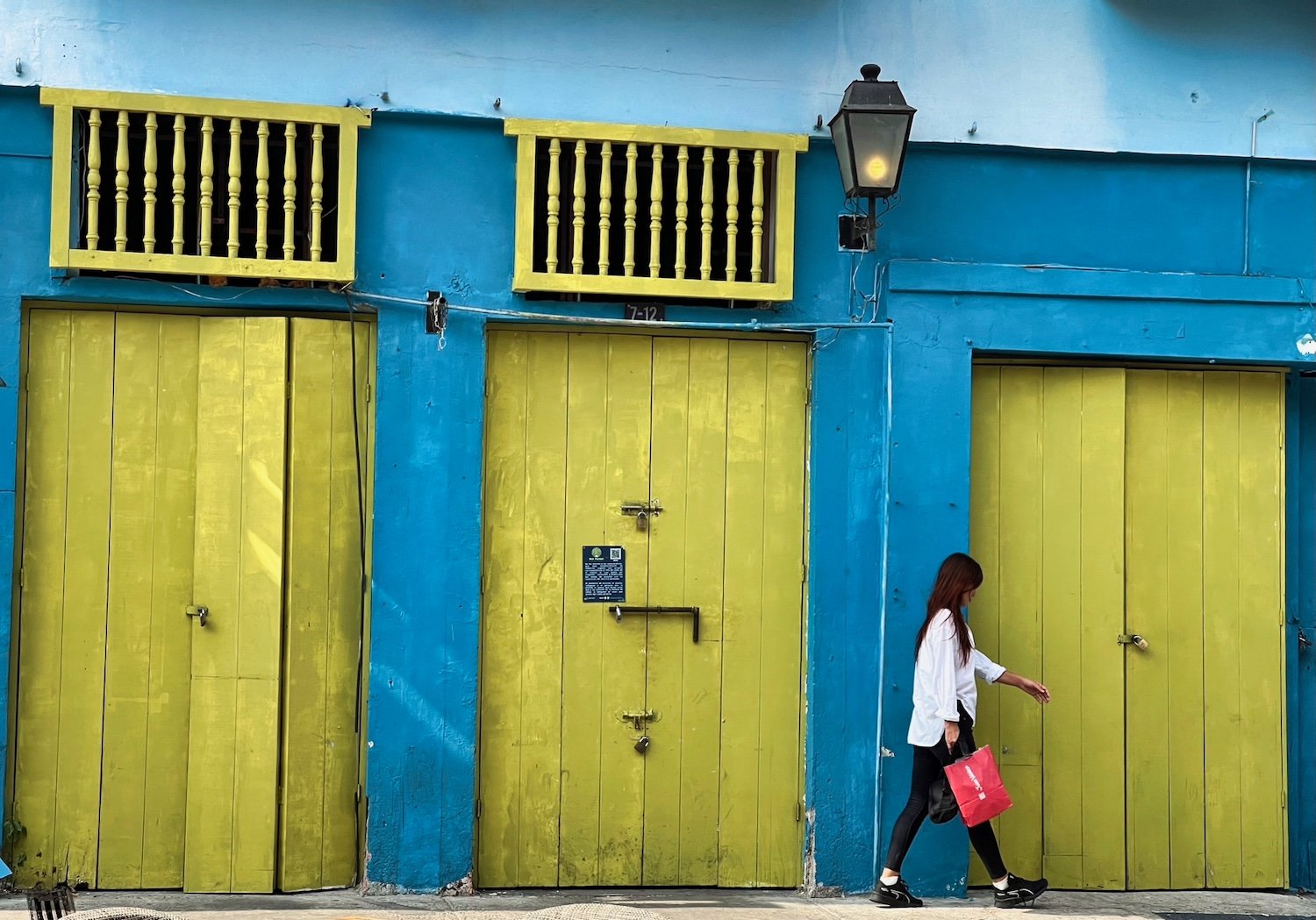
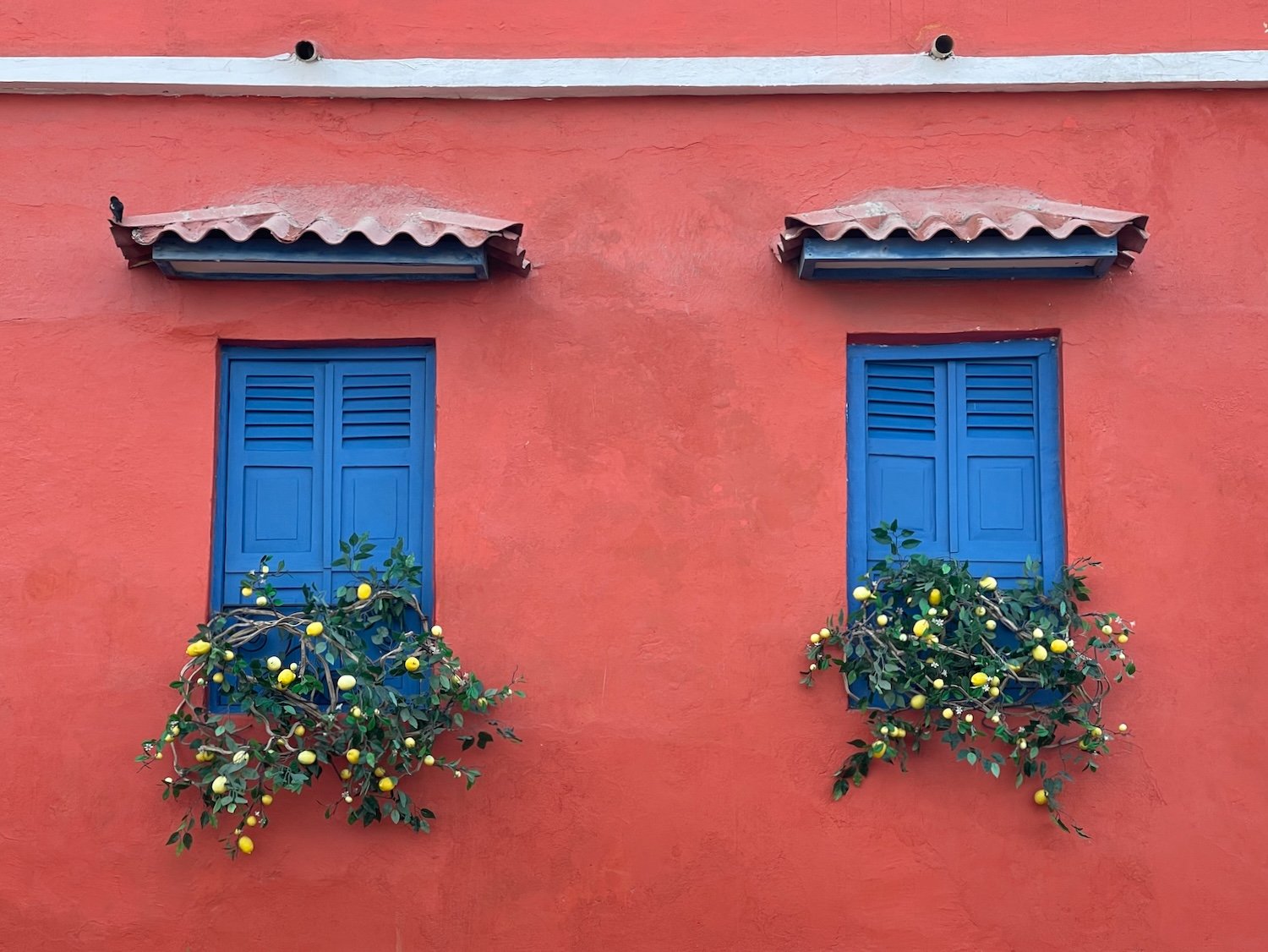


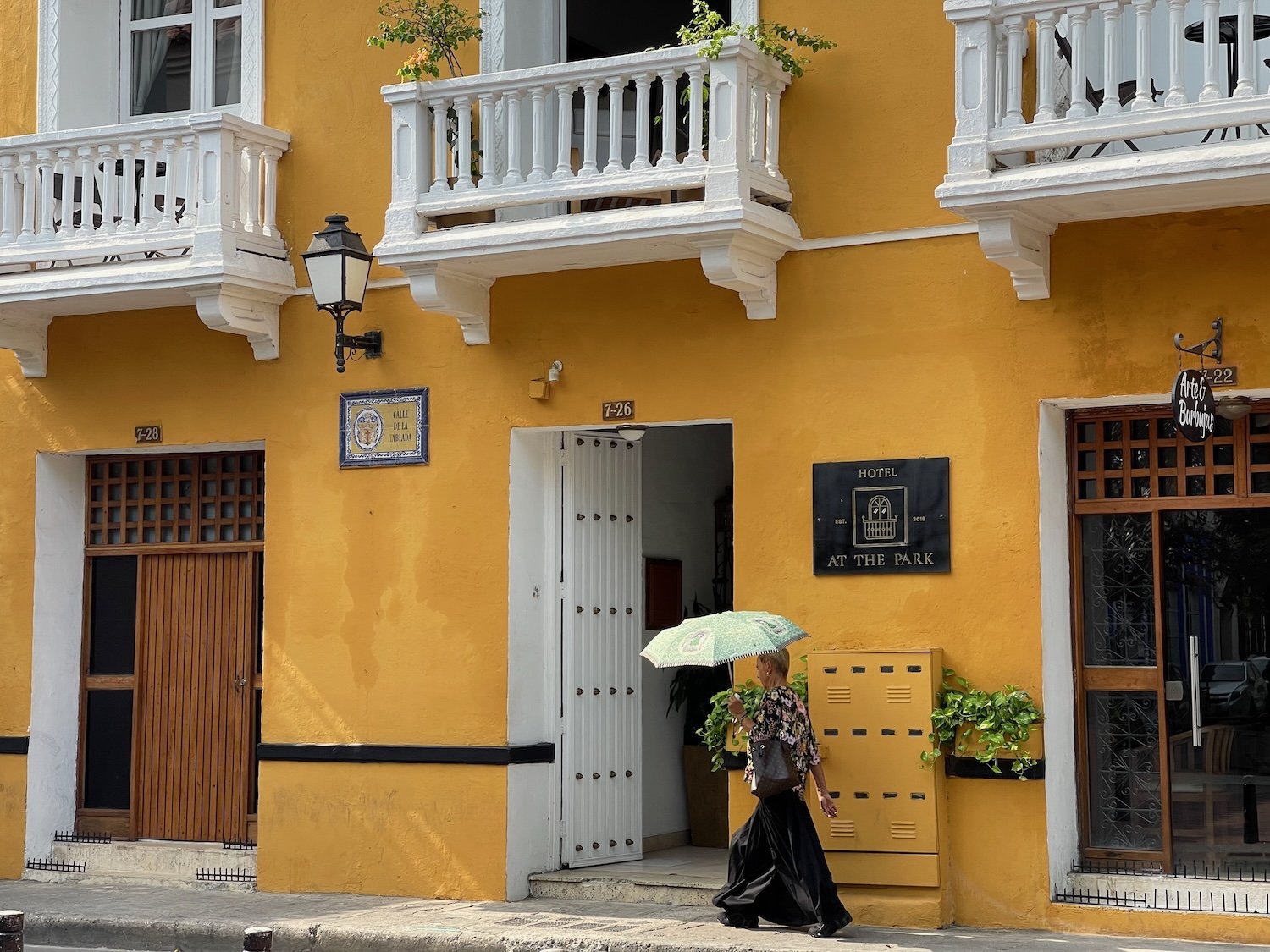
Wandering the streets of Cartagena, you can’t help but notice the large size and artistic quality of the door knockers on many old, wooden doors. This is a legacy from the Spanish colonial era, when the knocker on your door told passers by something about your profession and social status. Lizards were the most prestigious forms, denoting the uppermost classes, including royalty. Lions signified members of the armed forces - protectors of the city. Nautical themes, like fish, seahorses, and octopuses, connected the owners to seafaring professions. We had fun checking out the various knockers around town.
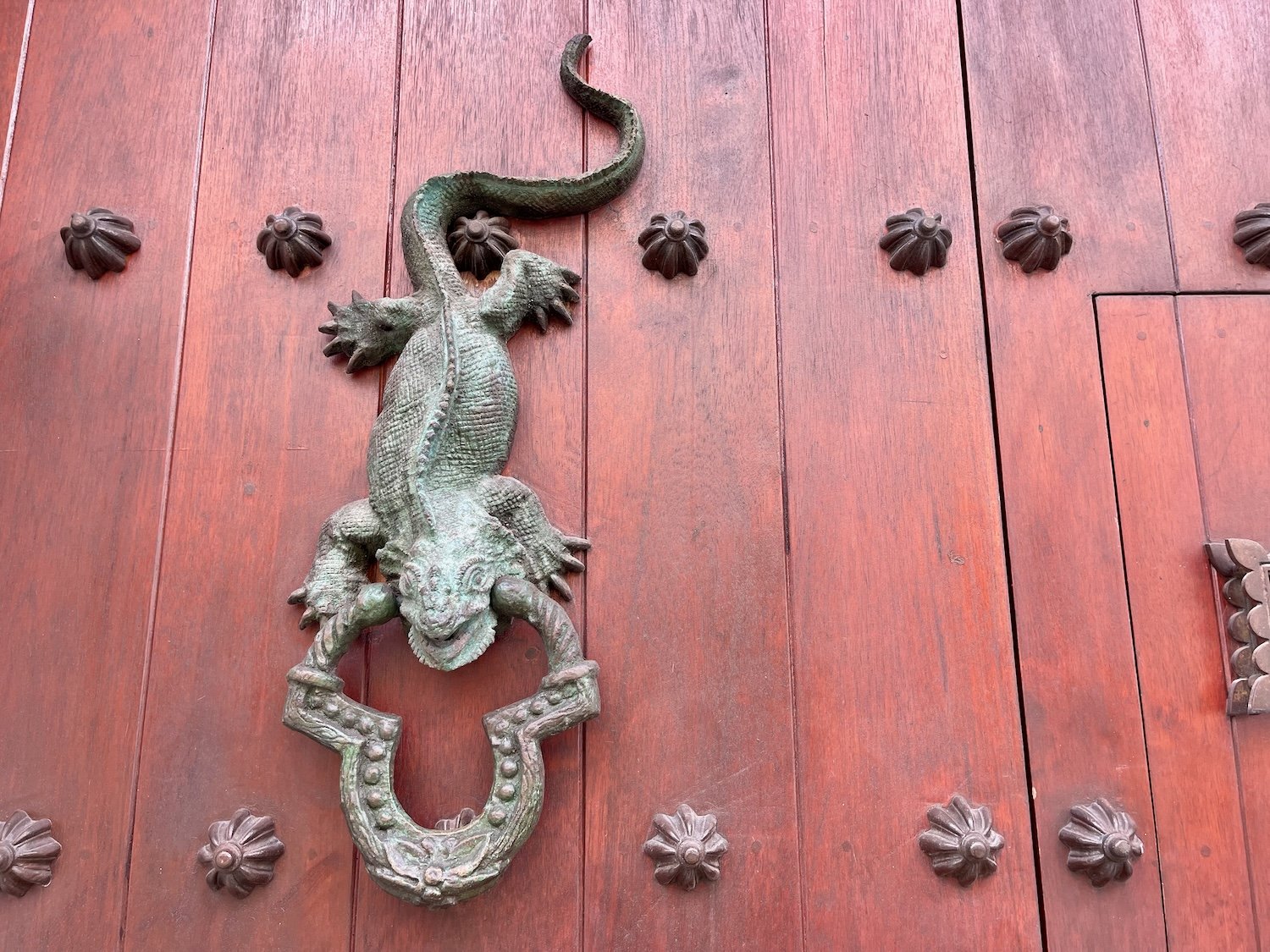
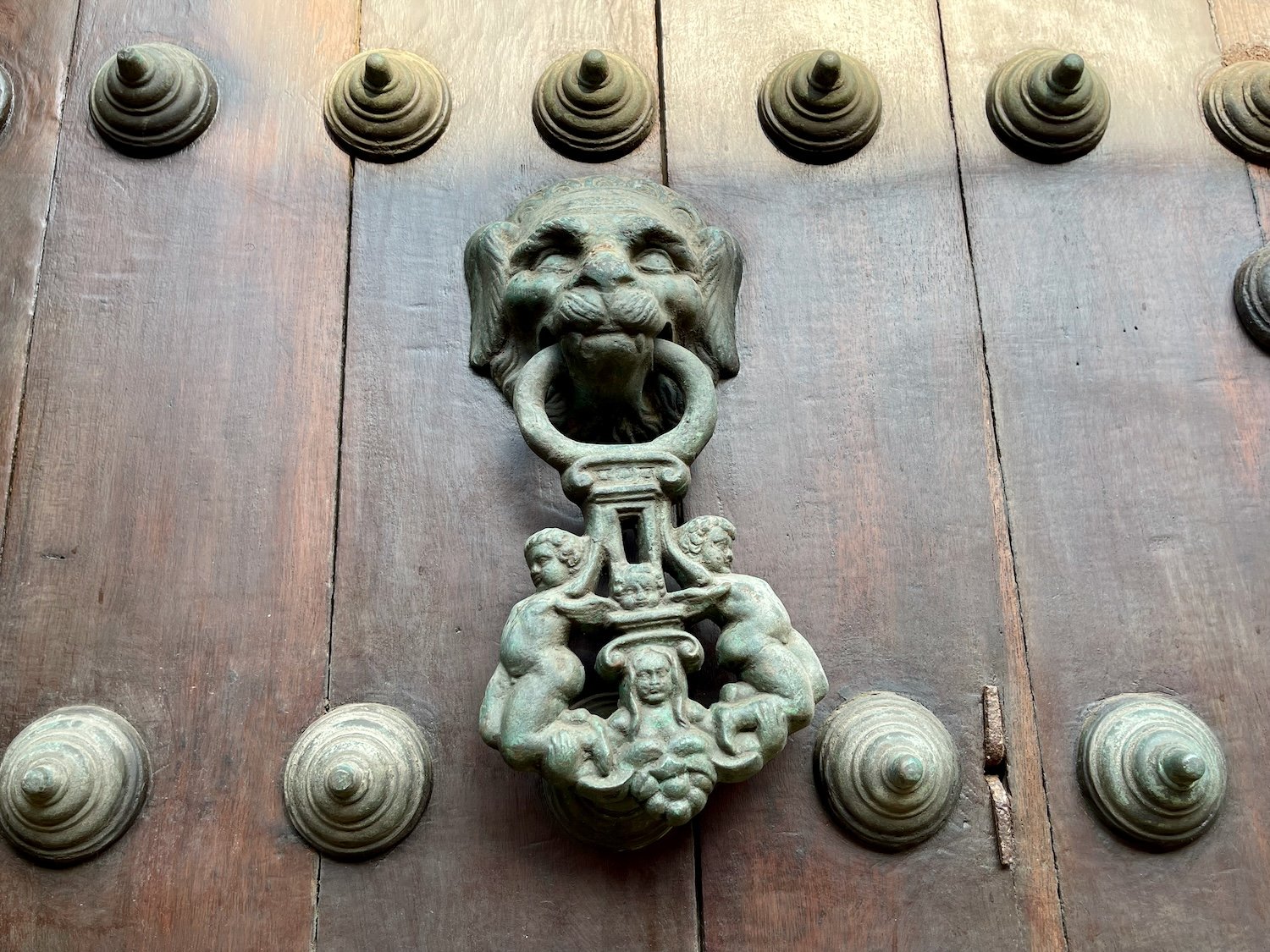
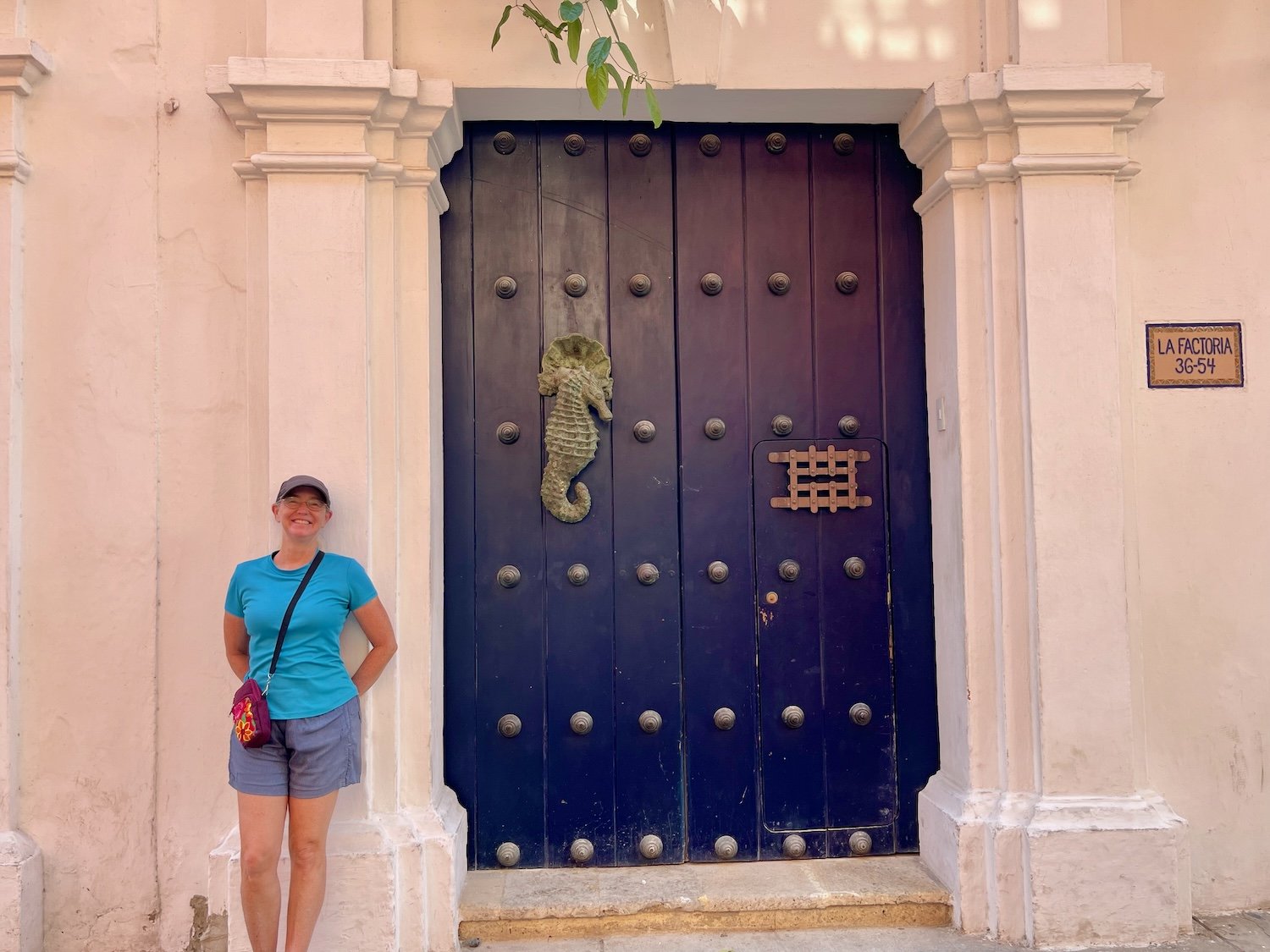
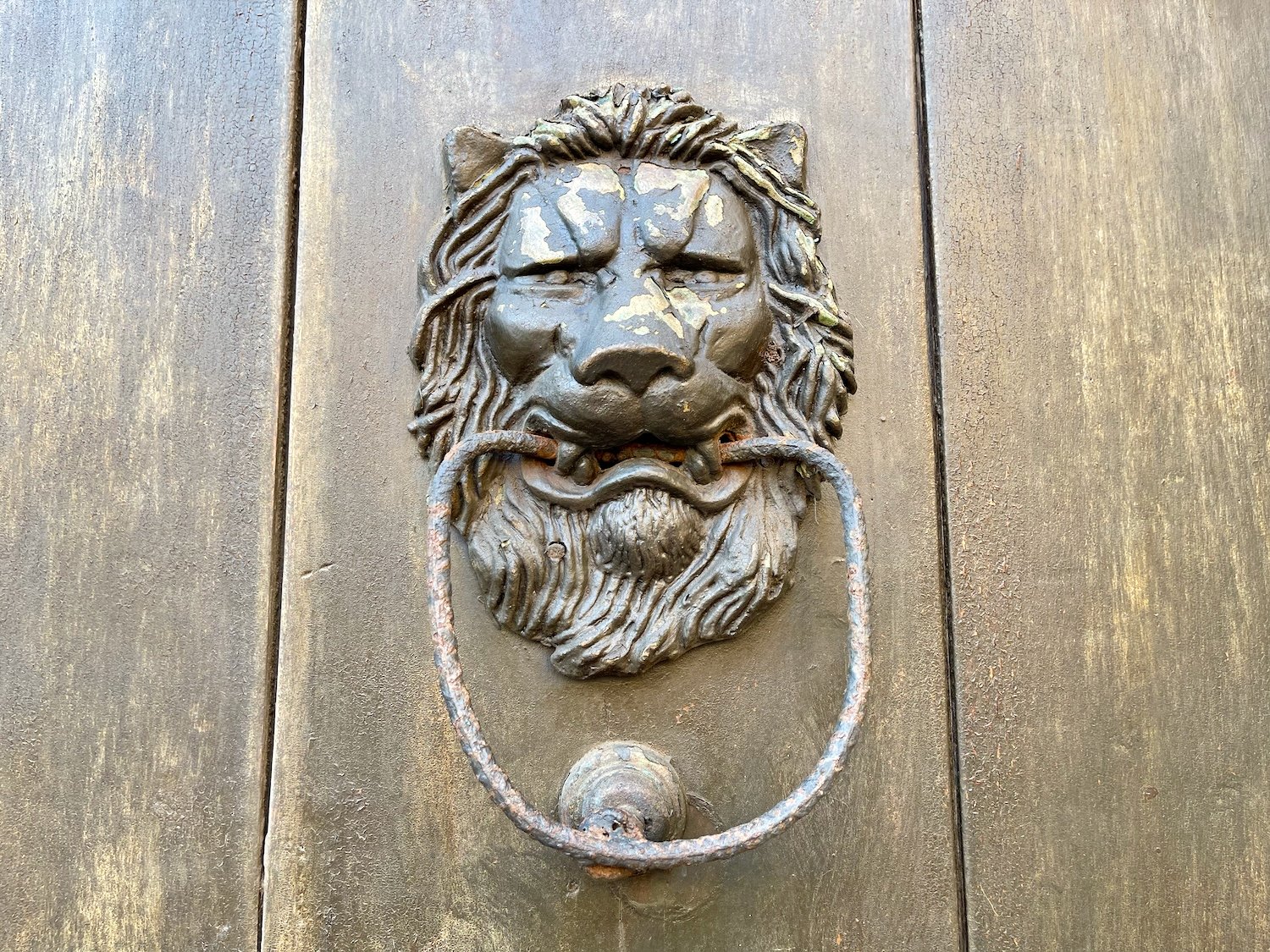
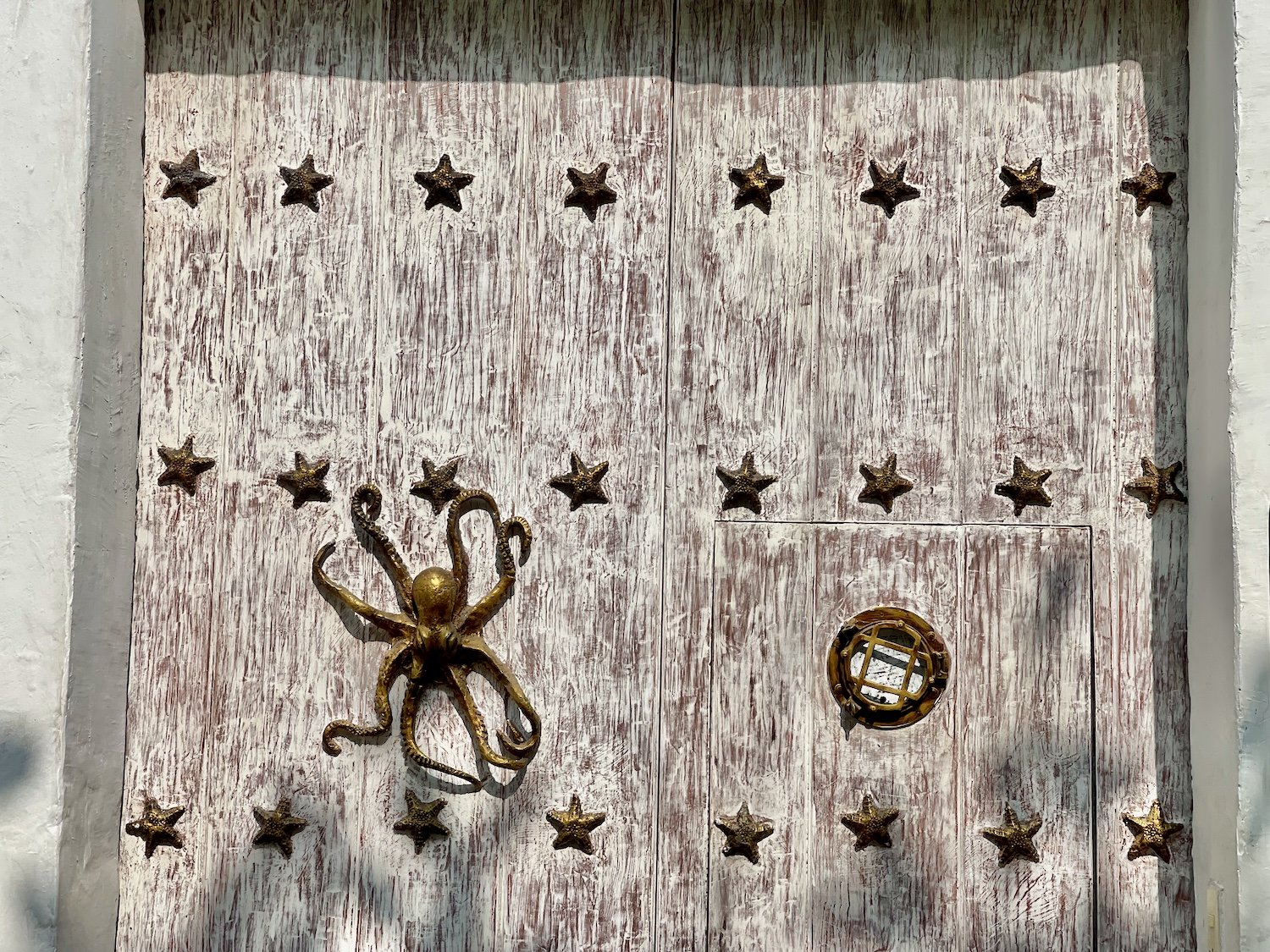

One of the most iconic structures in Cartagena is the wall around the old city. It’s among the best-preserved, colonial-era walls in the Americas, with most of the original ramparts still standing. A classic activity is to walk along the heights of the wall, taking in the vistas of the old town and the sea. We enjoyed a quiet morning walk along the wall, and over to the base of Cartagena’s imposing, hilltop fort - the Fort of San Felipe de Barajas.
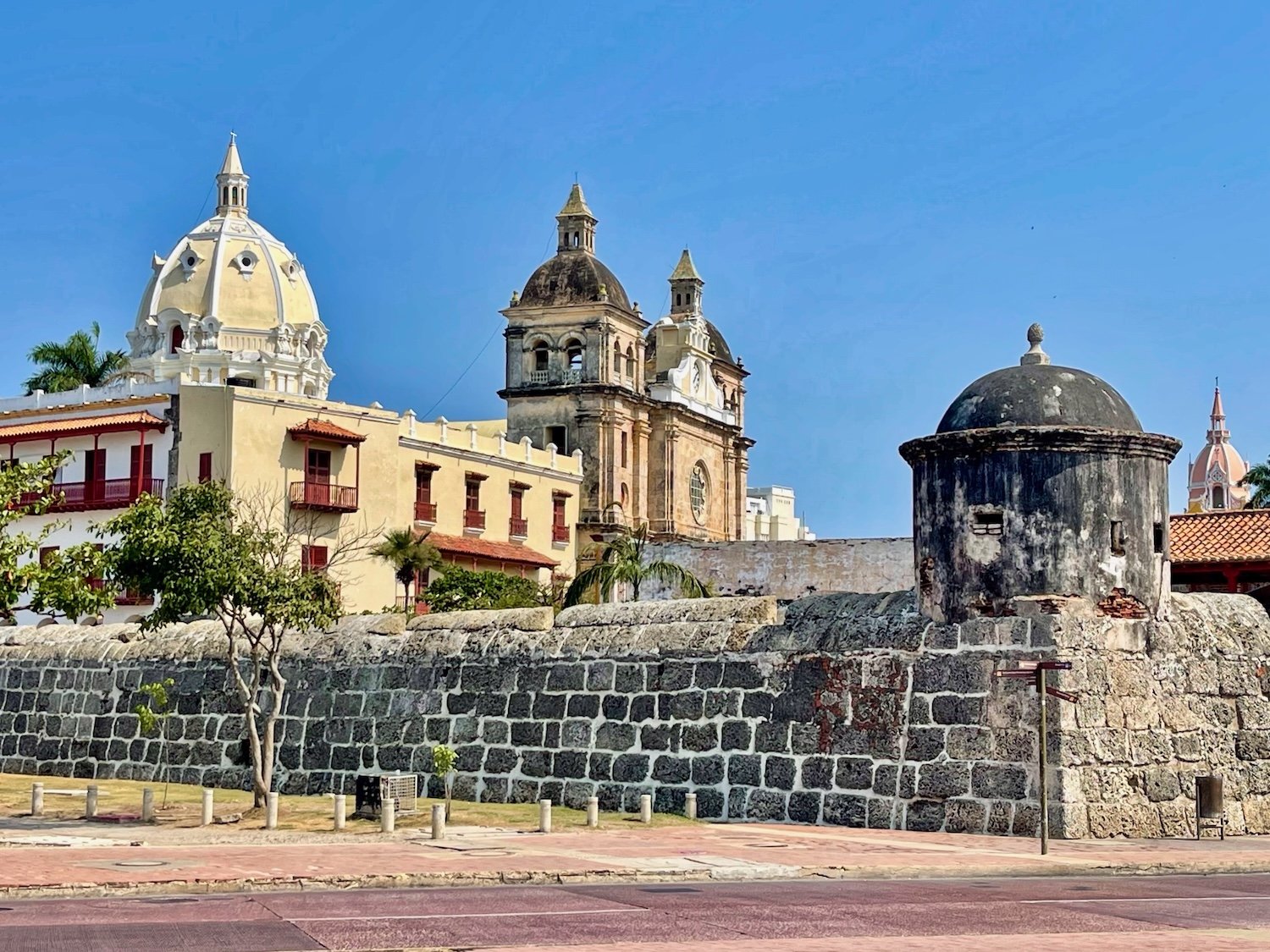
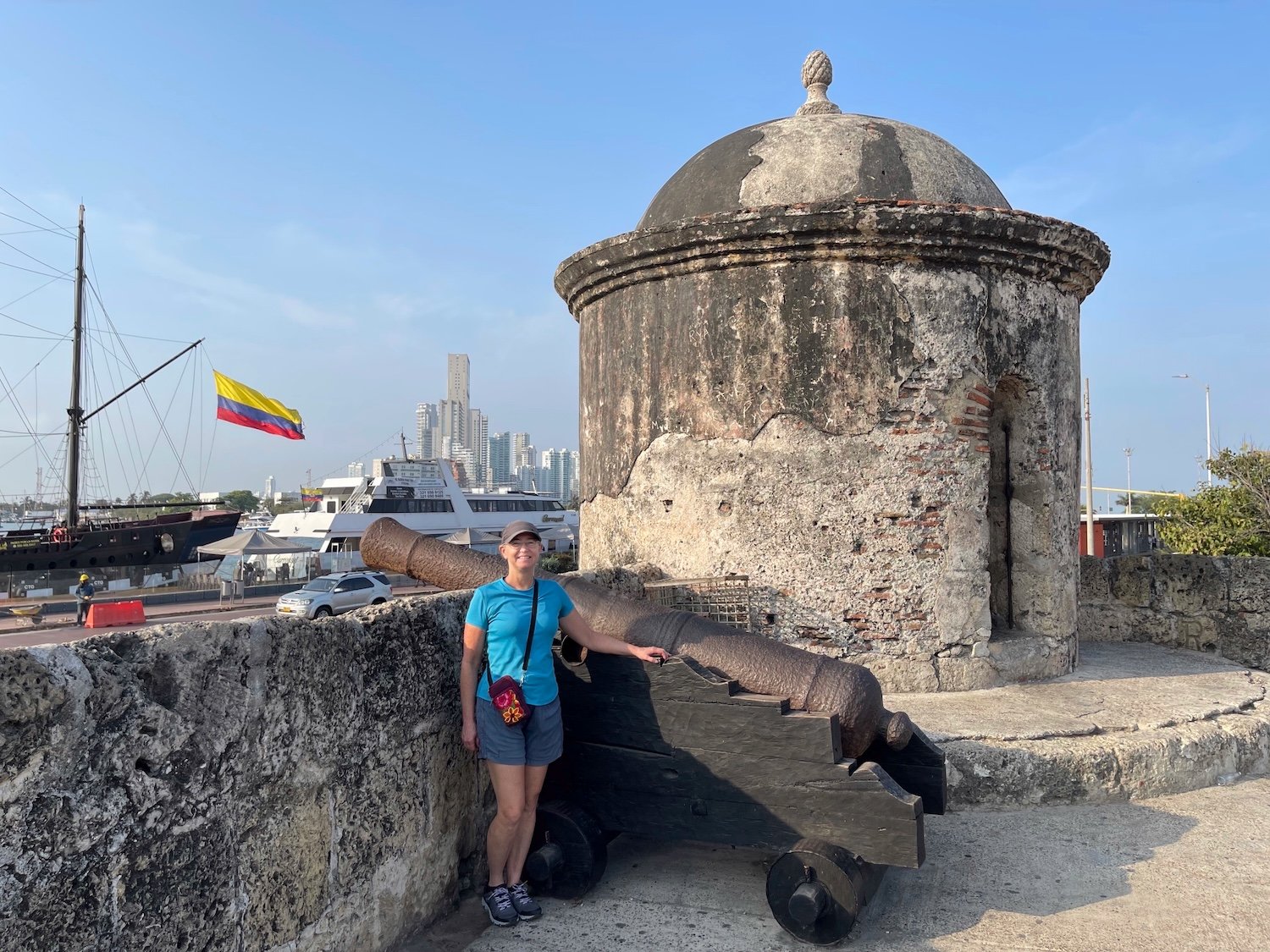
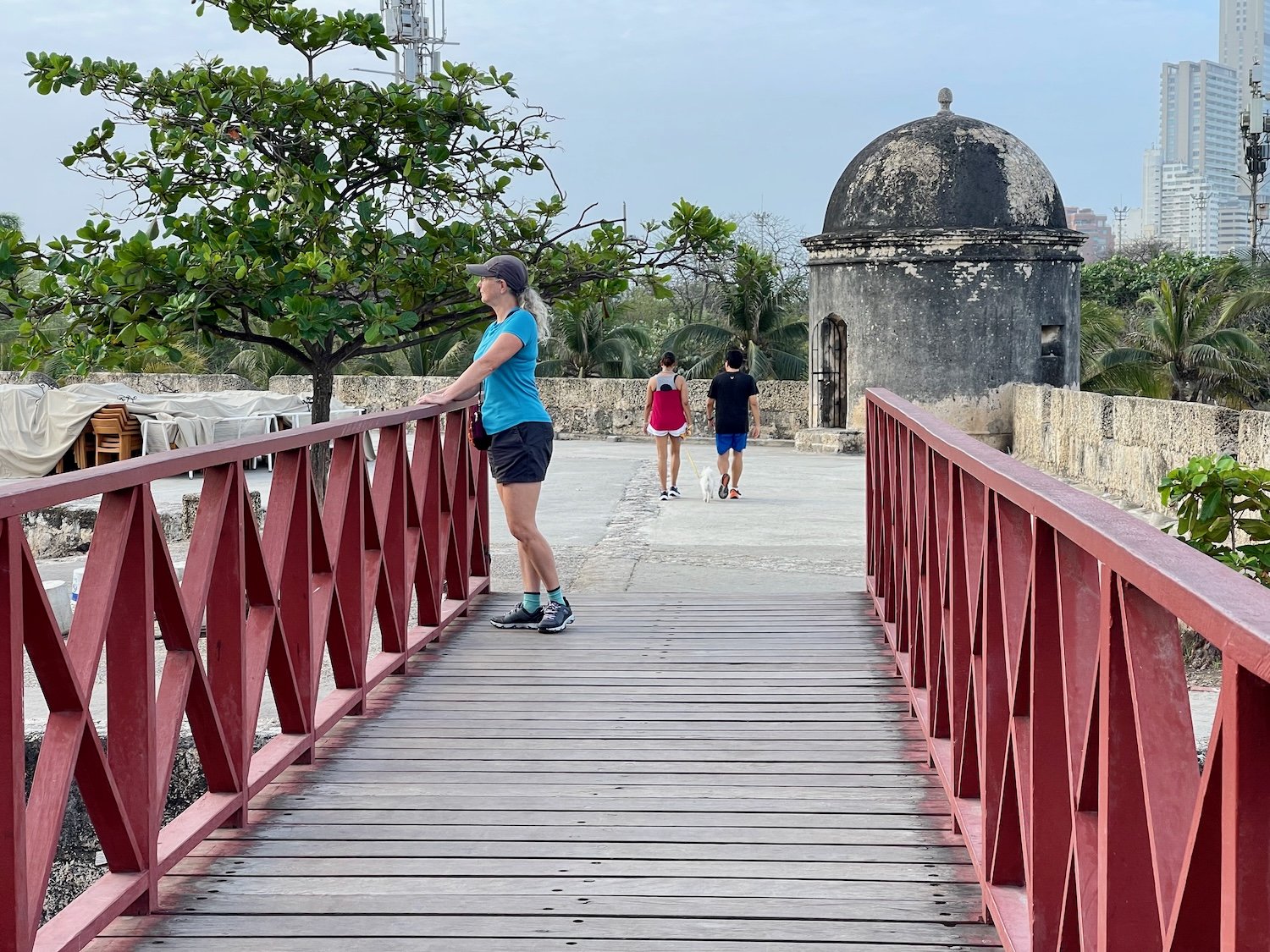
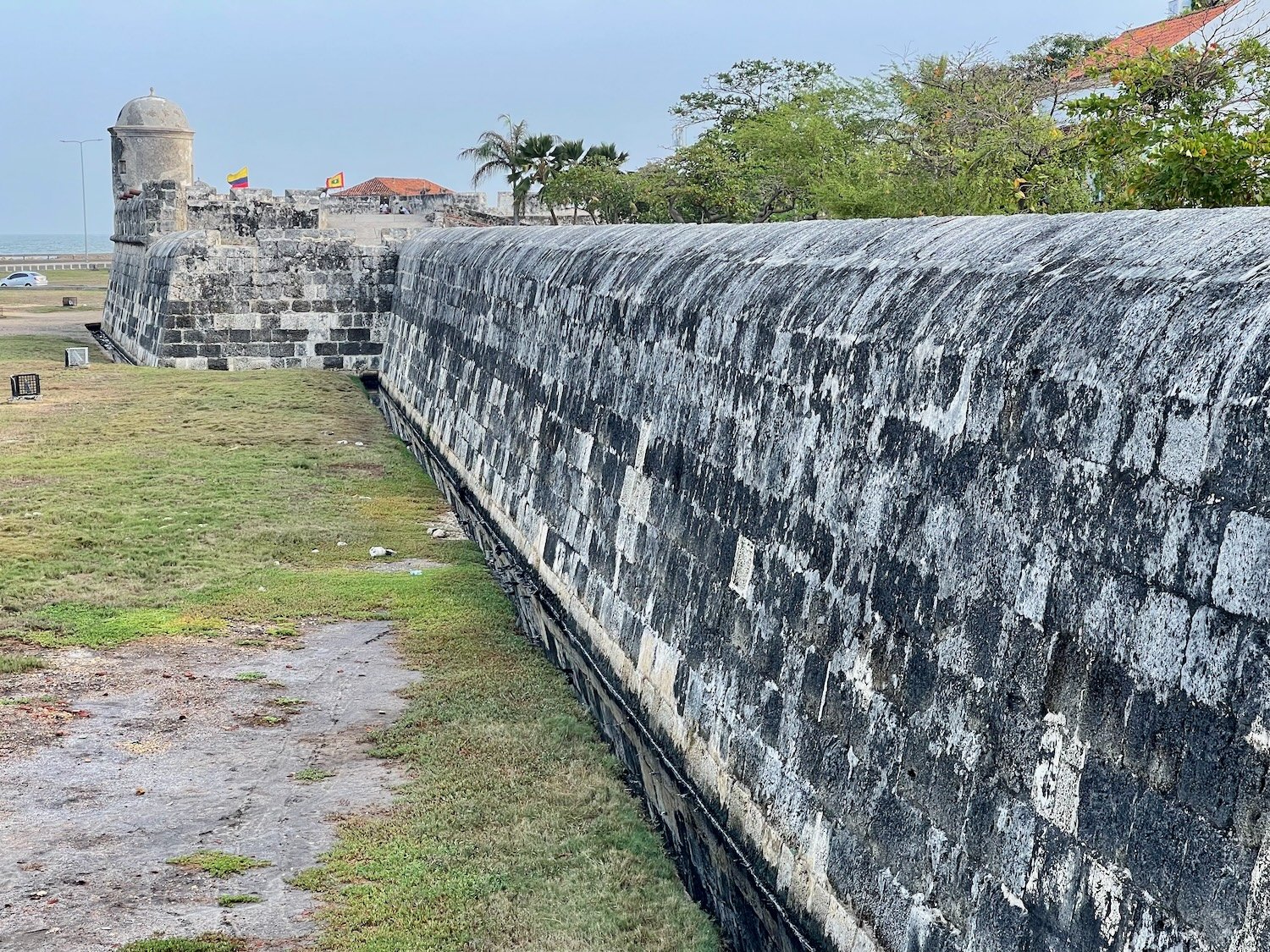

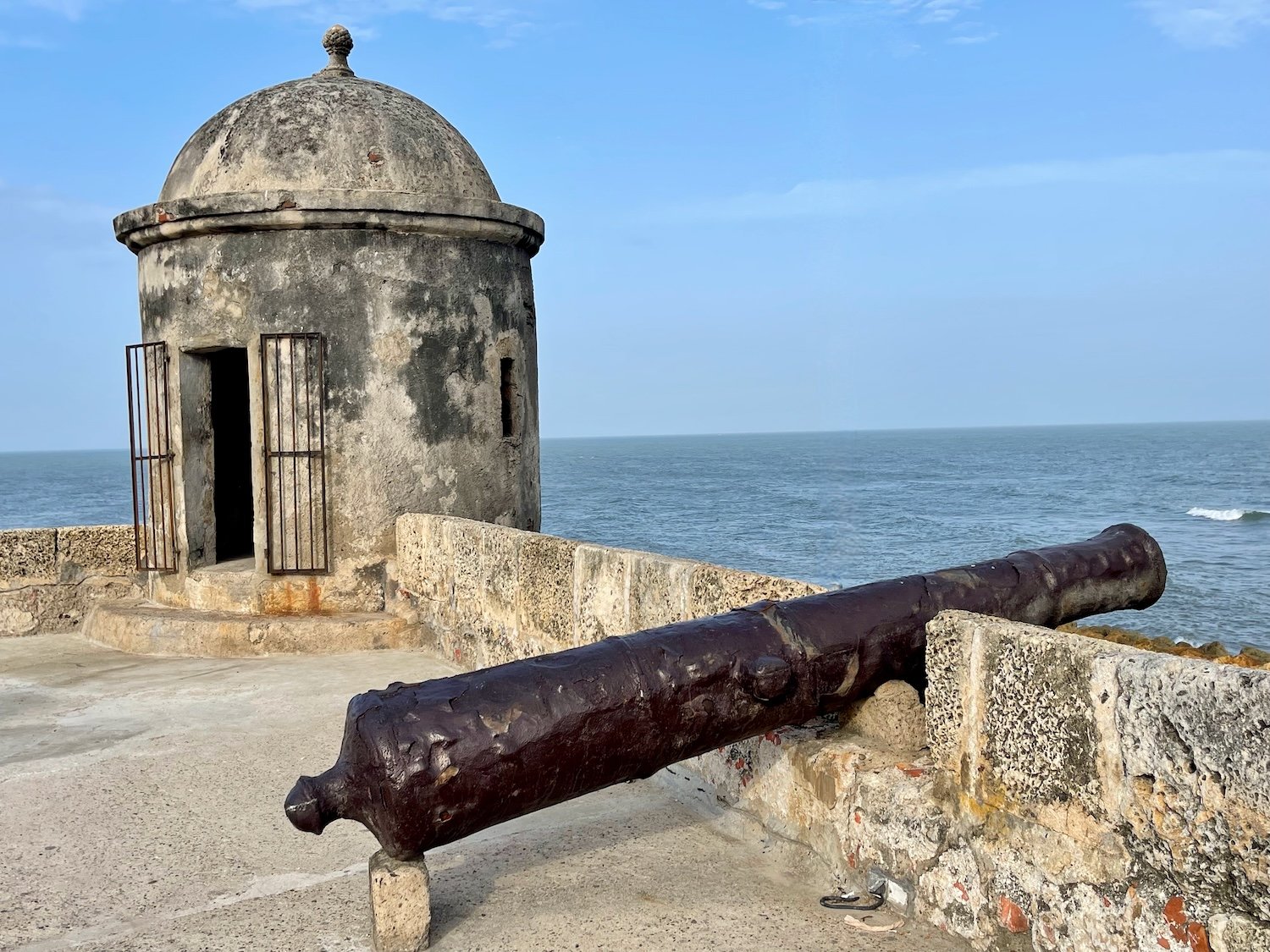
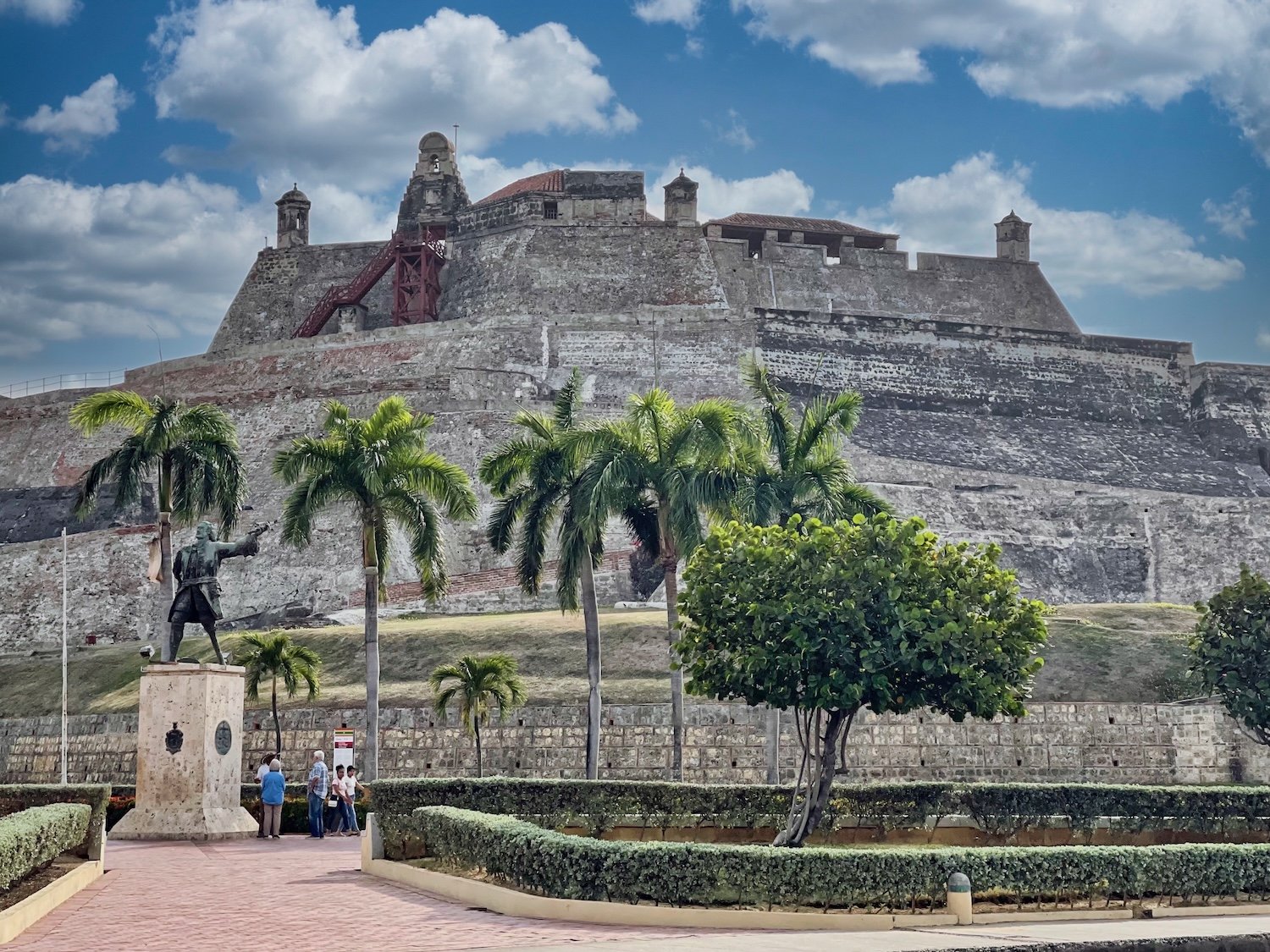
Of course, we also had some work to do to prep our bikes after the flight from Panama City. Fortunately, our bike boxes did the trick and the bicycles arrived in Colombia unscathed. We re-attached the front racks, mounted the front tires, re-attached the saddles, re-installed the pedals, re-mounted the handlebars, and pumped up the tires. A couple of other maintenance steps - like changing the oil in our internal-gear hubs and mounting a new odometer for PedalingGuy rounded out our work. We were very happy that this time (unlike in Panama City) we didn’t run into any problems. It was nice to have some drama-free maintenance, for a change. Before long we were ready to roll.
Pumping up the bicycle tires after the flight from Panama City. They say you’re supposed to let some air out of the tires so they don’t get over-inflated due to changing pressure during the flight. But some think that this is just a myth, and that the pressure difference is not enough to harm tires. We decided to let out some air, to be on the safe side. Cartagena de Indias, Bolívar Department, Colombia. Copyright © 2019-2024 Pedals and Puffins.
After seven days, we were ready to hit the road and leave Cartagena behind. We enjoyed one last, rose-colored sunset over the Caribbean. Cartagena de Indias, Bolívar Department, Colombia. Copyright © 2019-2024 Pedals and Puffins.
Cycling Across the Caribbean Lowlands
We spent the next six days (plus a few layover days) cycling across the low-lying, coastal zone of northern Colombia. Each day we followed a similar routine, rising before 5:30am to get out on the road as early as possible. Like much of Central America, the weather in Colombia was very hot and humid. So our pattern involved cycling early in the morning, and attempting to reach our destination around (or even before) noon. Many days we cycled through light rain or drizzle, but we didn’t mind. Clouds and light rain helped to keep the temperatures comfortable. Afternoon siestas were definitely preferred.
The ride out of Cartagena was pretty hectic. Initially we cycled along the waterfront which was nice, especially since we had a bit of a bike lane there. But for the next 10 miles we rode through city traffic. It was a relief when we finally reached the edge of the city, and left the urban craziness behind. From then on, we mostly rode on a nice, wide road shoulder which made the cycling fairly fast, and pleasant.
Heading out from Cartagena, we passed this sign. At more than 600 km (375 mi), we had a long way to go before reaching Medellín, the next big city along our route. And that was if we took the most direct route (which we did not). Ruta Caribe (Hwy 90B), Bolívar Department, Colombia. Copyright © 2019-2024 Pedals and Puffins.
About two-thirds of the way up Colombia, the Andes Mountains peter out into a broad plain blanketed with wetlands and savannas. Culturally, this area has very strong ties to the Caribbean, and we could feel that influence everywhere. Colombia also has a very deep farming tradition, so most of the lowlands were converted to pastures and agriculture long ago.
The palm-thatched roof at this roadside truck stop was one of many signs of the Caribbean cultural influence in Colombia’s northern lowlands. This was one of the larger palm-thatched roofs we have seen. El Mulero Truck Stop, Ruta Caribe (Hwy 90B), Bolívar Department, Colombia. Copyright © 2019-2024 Pedals and Puffins.
The first day out, we cycled through a mosaic of dry savannas with scrubby, thorny trees, interspersed with wetlands and ponds. Recent rains had filled the wetlands, and the ditch along the side of the road was brimming with water. There were lots of birds. And a succession of ‘road crossing’ signs indicated that there were probably other creatures (like crocodiles and anteaters), but we didn’t see any of those.
Ruta Caribe (Hwy 90B), Bolívar Department, Colombia. Copyright © 2019-2024 Pedals and Puffins.
Ruta Caribe (Hwy 90B), Bolívar Department, Colombia. Copyright © 2019-2024 Pedals and Puffins.
A common, but very entertaining bird was the bicolored wren. They have a very loud, chortling, tropical-sounding call that pairs of birds sometimes sing in a duet. They’re also cooperative breeders, where blood relatives help the breeding pair defend the nest and feed the young. Ruta Caribe (Hwy 90B), Bolívar Department, Colombia. Copyright © 2019-2024 Pedals and Puffins.
Several snail kites lurked on fence posts near the water-filled ditches along the highway. They feed almost exclusively on apple snails, which live in slow-moving streams, ponds and ditches. When you go to a restaurant and order escargot (snails) you are given a tool to pull the snail from the shell. The long, curved bill of the snail kite serves the same purpose. Ruta Caribe (Hwy 90B), Bolívar Department, Colombia. Copyright © 2019-2024 Pedals and Puffins.
Some of our favorite, new birds were the northern screamers. They’re really big - about the size of a turkey. They’re also one of the few types of birds that has bony spurs on the front of their wings. However, as can be seen in the photo, the screamer’s spurs are particularly pointy on the ends, and can do some real damage when the birds fight over territories. Ruta Caribe (Hwy 90B), Bolívar Department, Colombia. Copyright © 2019-2024 Pedals and Puffins.
By mid morning we were both hot and sweating profusely. Stopping didn’t help, even in the shade. In fact, it was better to keep cycling so that the breeze created by movement could help keep us cool.
We were very glad to finally arrive at Cruz del Viso, a remote crossroads where we had hoped to score a hotel room with air conditioning. You can thus imagine our disappointment when the folks at the restaurant there told us that the hotel had been closed for nearly two years. It was our first indication that Google Maps is even worse in Colombia than it had been in Central America - and we wouldn’t be able to trust that services shown on the map (like hotels) were really there.
That was a real problem for us. By this time it was around noon, and horrendously hot. We were both battling dehydration, and did not relish the idea of cycling much further to find another hotel (the next one we knew about was another 10.5 miles (17 km) away).
Hot and tired - we settled into some chairs in the shade to rehydrate and consider what to do next. That’s when one of the waitresses told us that there was another hotel (which did not show up in Google Maps) just two miles away (3.2 km), at a gas station. It was off route for us, but we didn’t care. Two miles sounded fabulous. We finished our drinks and headed down the road to a tiny motel with just six rooms. For only US$14 per night, it included air conditioning. Nothing else mattered. We happily checked in.
Later in the evening we cycled into the town of Malagana (pop. 6,084) to buy some drinks for the next day. While we were packing up the bikes after shopping, a friendly guy came over to introduce himself. Jerónimo told us he was a cyclist. He was particularly interested in our Rohloff Speedhubs (with internal gears) - even taking a photo of them. A small crowd gathered now that Jerónimo had broken the ice by talking to us. He took a group photo of us with his son and daughter, who were with him. Some other folks in the crowd seemed impressed when they learned how far we had cycled. It was fun.
Heading for the Coast
Over the next couple of days our route turned southwest, heading back towards Colombia’s Caribbean coast. Long, flat stretches of road were mostly bordered by groves of oil palms, mixed in with a few rice fields. Whenever we crossed some hills, the palms were replaced by banana plantations and pastures. But what struck us the most was the mangoes, which were clearly in season. Everyone seemed to own a huge mango tree or two. And many families set up rickety, wooden stands along the road with a pile of fresh mangoes for sale. We must have passed hundreds of them over the course of several days. Even the margin of the road was full of smushed mangos that we had to swerve around as we rode.
This boy seemed quite proud of his fish. It was a Magdalena sorubim - a type of long-whiskered catfish native to South America. This particular species is found only in the Magdalena River of Colombia, and its bigger tributaries. It’s considered an endangered species due to its rapidly declining population, but it is still legally harvested and sold commercially in Colombia. Majaguas, Bolívar Department, Colombia. Copyright © 2019-2024 Pedals and Puffins.
As we approached the coast, the wetlands became even more expansive - frequently populated by a variety of wading birds, like this rufescent tiger-heron. Matuya, Bolívar Department, Colombia. Copyright © 2019-2024 Pedals and Puffins.
In areas with more trees, we passed a couple of highway crossings for arboreal creatures like sloths. Pita En Medio, Sucre Department, Colombia. Copyright © 2019-2024 Pedals and Puffins.
This aerial ‘bridge’ was constructed to help sloths and monkeys cross the road in relative safety. Pita En Medio, Sucre Department, Colombia. Copyright © 2019-2024 Pedals and Puffins.
In the first coastal town we reached, we stopped for some fresh-squeezed orange juice at a small, roadside cafe. The oranges weren’t very juicy, and it took the poor girl who was serving us forever to squeeze enough juice for our drinks. But it was worth the wait. The fresh juice was delicious. Santiago de Tolú, Sucre Department, Colombia. Copyright © 2019-2024 Pedals and Puffins.
As we were cycling along the coastal road something caught us both by surprise. There was a guy riding down the road on his motorbike, with a washing machine balanced precariously on the back! He had one hand on the handlebars, and his other arm was stretched backwards above his head, grabbing the rim of the washing machine. It was mind-blowing - and a bit unnerving - to see that.
The truth is that folks in many parts of Latin America rely heavily on motorbikes for all their transportation, and it’s fairly common to see large objects (e.g., pieces of furniture, over-sized sacks of fruits or vegetables, large musical instruments, and even a goat or pet dog) being hauled around on them. It’s also very common to see three or four people crammed onto one motorbike (although at least one of them is usually a little kid). In this part of Columbia motorbikes (i.e., small motorcycles) outnumber cars on the road by 4 to 1. Unlike in the United States, where most people ride large, overpowered motorcycles for pleasure, the ones in Colombia are usually small, 100-200 cc motorbikes that are mostly utilitarian.
Lots of buildings in the coastal towns had palm-thatched roofs, and the open, airy architecture typical of Caribbean communities. Boca de la Ciénega, Sucre Department, Colombia. Copyright © 2019-2024 Pedals and Puffins.
Crossing a river as it empties into the Caribbean Sea. Boca de la Ciénega, Sucre Department, Colombia. Copyright © 2019-2024 Pedals and Puffins.
Hanging Out in a Colombian Beach Town
We arrived in the beach town of Coveñas (pop. 17,100) around noon on a Sunday. It was a sun-drenched, bustling place that’s very, very popular as a weekend getaway for Colombians coming from the nearby mountains. All afternoon, the beachfront bars and rent-an-umbrella spots on the sand were packed with families and young adults out enjoying a day by the sea. But its most distinctive characteristic was that it was LOUD. Multiple restaurants and shops blared music at ear-splitting levels. We could even hear the ruckus from our hotel room, which was a quarter mile away.
A fun mural on the wall of our hotel. Coveñas, Sucre Department, Colombia. Copyright © 2019-2024 Pedals and Puffins.
After settling in, we headed over to the beach to observe the mayhem. Families lounged on beach chairs while their kids ran loose among the snack bars and playgrounds. The water was full of people soaking in the surf - many more than in Cartagena. But there was something that was definitely missing - foreigners. This hopping seaside resort was well off the beaten path for international travelers. We may have been the only English-speakers in town that weekend.
Our lunch came with fish soup as a starter - but not the kind of fish soup we are used to. There were big chunks of fish with the bones still in them. It was a challenge to eat the soup without swallowing a fishbone. We probably wouldn’t order the fish soup again. (In fact, PedalingGuy later came down with a lingering stomach bug, and we suspected the source was the fish soup.)
In the evening, floodlights illuminated the coconut palms along the beach. Coveñas, Sucre Department, Colombia. Copyright © 2019-2024 Pedals and Puffins.
The next morning we went for a walk along the road that paralleled the ocean. The street was lined with small restaurants and family-run hotels targeting the domestic travelers. In the morning, things were a lot more calm, even though there were a fair number of people out and about. It was like we had gone back in time to an era when beaches were more low-budget, low-key places to hang out.
Handmade signs captured the low-key vibe among the family-run restaurants and hotels. Coveñas, Sucre Department, Colombia. Copyright © 2019-2024 Pedals and Puffins.
A blue-headed parrot searched for fruit in a tree by the road. Coveñas, Sucre Department, Colombia. Copyright © 2019-2024 Pedals and Puffins.
This yellow-hooded blackbird stood out among the marshy vegetation in a vacant lot. Coveñas, Sucre Department, Colombia. Copyright © 2019-2024 Pedals and Puffins.
A Land of Rivers and Wetlands
From Coveñas we turned back inland across the soggy coastal plain, traversing grasslands, savannas, wetlands and ponds used mostly for cattle farms. It was already very warm by 6am, so we pressed on without stopping much - hoping to cover 45 miles (72.4 km) as quickly as possible. At one point a motorbike slowed down next to PedalingGuy so that the passenger could hand him a bottle of cold water. That was a wonderfully thoughtful gesture.
Along the way we had our first encounter with the wide, chocolate-colored Sinú River. Arising in the treeless heights of the Andes, it is Colombia’s third-largest river, and perhaps the most important from an agricultural perspective. The lowlands surrounding the Sinú River have some of the most fertile soils in the country, and 70% of the people in the region live along its banks.
Near a bridge crossing, we saw these long, wooden boats unloading gravel into piles on the riverbank. Sinú River, Santa Cruz de Lorica, Córdoba Department, Colombia. Copyright © 2019-2024 Pedals and Puffins.
A flock of white-faced whistling-ducks in one of the wetlands took off nervously when we stopped to have a look. Cotorra, Córdoba Department, Colombia. Copyright © 2019-2024 Pedals and Puffins.
The Hotel Zeus in the town of Cereté (pop. 108,500) is well known among cyclists for being clean and inexpensive. But what set it apart was the warm hospitality of the owner, Jorge. He seemed genuinely enthusiastic to have us stay at the hotel, and eager to help us find the right room to suit our needs. The rooms were simple, but quiet in a very busy town - not always an easy thing to find.
The all-white San Antonio de Padua Church glowed in the evening light, on one side of the central plaza. Cereté, Córdoba Department, Colombia. Copyright © 2019-2024 Pedals and Puffins.
We got a kick out of this mural. It had inklings of Leonardo Da Vinci (Mona Lisa), Van Gogh (Starry Starry Night) and Salvador Dali (self portrait) all in one mural. Each image was embellished with local motifs (e.g., the flower in Mona Lisa’s hair). Cereté, Córdoba Department, Colombia. Copyright © 2019-2024 Pedals and Puffins.
Sunset over the city streets, as seen from the second story of our hotel. Cereté, Córdoba Department, Colombia. Copyright © 2019-2024 Pedals and Puffins.
A short ride from Cereté took us to the biggest city in the region, Montería (pop. 491,000). It turned out to be a very bicycle-friendly place. Within five miles after departing Cereté we were cycling on a nice bike path that brought us all the way into the city. It was May first, a national holiday, so there were lots of folks out enjoying the path. Most people were walking or jogging, but there also were a few other cyclists. Best of all, the path was lined with trees that provided a blanket of shade that helped keep us cool.
In the heart of the city we passed a bike store called Go, Rigo, Go! It’s part of a chain of bike shops owned by Rigoberto Urán, one of Colombia’s internationally-famous cycling stars. Apparently he’s quite a celebrity in Colombia, sponsoring local bike races and lending his smiling face as a pitchman for a number of different products.
Over the last 10-15 years, Colombians have been making a big impression in professional cycling. They are particularly competitive in the mountain stages of races, which might be expected given the the high elevation of the Andes where they are frequently raised or train. As we write this, the Giro d’Italia one of the most important multistage bike races of the year, is happening. This year’s Giro d’Italia has six competitors from Columbia, a particularly high number for a country of its size.
This ‘Bicycle Monument’ was just one of the many indicators that Montería was a very bicycle-friendly city. Montería, Córdoba Department, Colombia. Copyright © 2019-2024 Pedals and Puffins.
In the evening, the columns supporting the street lights along the main road were illuminated by strings of lights inside the lamp posts. It looked great. Montería, Córdoba Department, Colombia. Copyright © 2019-2024 Pedals and Puffins.
We spent a couple of days in Montería waiting for some particularly rainy weather to pass, and enjoying the comforts of our modern hotel room (roadside hotels in Colombia can be fairly spartan). The city’s biggest tourist attraction was a 3-mile long (5 km) greenway on the banks of the Sinú River, which we visited a couple of times.
The city had a different take on the usual ‘letras’ sign - cutting the letters out of a large sheet of metal. Ronda del Sinú, Montería, Córdoba Department, Colombia. Copyright © 2019-2024 Pedals and Puffins.
The María Varilla Monument honors one of Colombia’s most famous folk dancers. She’s depicted dancing the ‘porro’ - a Colombian speciality - and surrounded by a bronze band playing traditional instruments. Ronda del Sinú, Montería, Córdoba Department, Colombia. Copyright © 2019-2024 Pedals and Puffins.
This monument honored another famous Colombian artist - the singer/songwriter Pablito Florez. One of his most famous songs was called La Aventurera, about a free-spirited woman who leaves him heartbroken. Here, she is portrayed watching him from a distance, with her suitcase. Ronda del Sinú, Montería, Córdoba Department, Colombia. Copyright © 2019-2024 Pedals and Puffins.
A couple of days earlier we had seen these long wooden skiffs unloading gravel downstream (photo above). In Montería, we saw where the gravel came from. A succession of the boats anchored in the center of the river, while their crews climbed into the water and filled the boats with buckets of gravel from the river bed. Notice the boat farthest to the right in this photo. The gunnels of the boat are so close to the waterline that you can barely see the boat (look for the two piles of dirt and boat motor). When the boat departed with its load, one of the two crew had to swim along side in order to not capsize the boat. Ronda del Sinú, Montería, Córdoba Department, Colombia. Copyright © 2019-2024 Pedals and Puffins.
These very long boats were common on the Sinú River. The square-looking boat in the background was a ferry, taking passengers across the river. Ronda del Sinú, Montería, Córdoba Department, Colombia. Copyright © 2019-2024 Pedals and Puffins.
Red-tailed squirrels were common along the greenway. We were impressed by the bright orange color of their fur. Ronda del Sinú, Montería, Córdoba Department, Colombia. Copyright © 2019-2024 Pedals and Puffins.
An orange-chinned parakeet watched the bustling scene along the greenway from the safety of its perch on a utility wire. Ronda del Sinú, Montería, Córdoba Department, Colombia. Copyright © 2019-2024 Pedals and Puffins.
There were several big, old trees in the waterfront park, like this massive fig tree. Ronda del Sinú, Montería, Córdoba Department, Colombia. Copyright © 2019-2024 Pedals and Puffins.
From Montería, the route continued across a landscape laced with wetlands and ponds. But the thing that made the biggest impression on us was that there were a whole lot of other cyclists out on the road (it was Saturday). Call it the Urán-Quintana-Bernal effect. Columbia’s world-class cyclists are loved throughout the country and have helped to greatly popularize cycling. It seemed like we passed a couple of hundred cyclists out on their road bikes in the rain. There were lots of solo riders, pairs and small groups - but also several larger groups that looked like clubs, and at least one very large peloton. Many of them waved and greeted us as we passed.
A lush, green wetland along our route. Cruce Carolina, Córdoba Department, Colombia. Copyright © 2019-2024 Pedals and Puffins.
In this part of Colombia we were struck by the fondness for decor that evoked mid-20th century America. Nearly every restaurant we visited had signs referencing US Route 66, and paintings of classic stars like Marilyn Monroe, Jimmy Dean, and Elvis. This giant Elvis portrait was hung in our hotel room. Planeta Rica, Córdoba Department, Colombia. Copyright © 2019-2024 Pedals and Puffins.
The cows here looked very different from the Holstein’s and Herefords we’re used to. We were particularly intrigued by the downward sweep of this cow’s horns. Plaza Bonita, Córdoba Department, Colombia. Copyright © 2019-2024 Pedals and Puffins.
We were thrilled when the sun came out on our final day’s ride to Caucasia. The grass in the pastures practically glowed in the light. Plaza Bonita, Córdoba Department, Colombia. Copyright © 2019-2024 Pedals and Puffins.
This giant longhorn beetle was 4 inches (10 cm) long. It was still alive, but lethargic. We moved it off the road hoping it might recover. Near Plaza Bonita, Córdoba Department, Colombia. Copyright © 2019-2024 Pedals and Puffins.
This handsome thick-billed euphoria also was fun to see. Near Plaza Bonita, Córdoba Department, Colombia. Copyright © 2019-2024 Pedals and Puffins.
Along the way we crossed over another one of the region’s big, middy rivers - the San Jorge River. In all of the rivers, the water was running quite high following the recent stretch of rainy weather. Puerto Córdoba, Córdoba Department, Colombia. Copyright © 2019-2024 Pedals and Puffins.
In the town of Caucasia we managed to get a spacious hotel room away from the road - so there wouldn’t be a lot of road noise. But there was a catch. We had to haul our bikes and gear up to the second floor, climbing several long flights of stairs.
Most hotels in Colombia aren’t much to look at from the outside, even the ones that are quite nice on the inside. We stayed at the Hotel Canoa, in the center of the photo. Caucasia, Antioquia Department, Colombia. Copyright © 2019-2024 Pedals and Puffins.
We had a pretty good room. Too bad it was at the top of several long, steep flights of stairs that we had to push our loaded bikes up. Caucasia, Antioquia Department, Colombia. Copyright © 2019-2024 Pedals and Puffins.
The Edge of the Caribbean Lowlands
Caucasia (pop. 76,700) lies at the southern edge of the Caribbean Lowlands, where the massive Cauca River (Colombia’s second-biggest river) comes out of the Andes Mountains and spreads onto the coastal plain. As a result, it occupies a strategic location for trade in both agricultural and mining products. There were no tourists in Caucasia (besides us). The focus of the city was commerce. We spent one last rest day there, before tackling the climb into the Andes Mountains.
Bright, new stained-glass windows glowed in the local church. La Inmaculada Church, Caucasia, Antioquia Department, Colombia. Copyright © 2019-2024 Pedals and Puffins.
This beat-up, old 4-wheel drive vehicle looked like it had a long, and interesting life. Caucasia, Antioquia Department, Colombia. Copyright © 2019-2024 Pedals and Puffins.
Although we were fairly close to the coast, these fish probably came from the nearby Cauca River or fish farms in the area. When we asked if we could take a photo, the fisherman replied, “baaaaaaaaa!” We took this as an unenthusiastic yes. Caucasia, Antioquia Department, Colombia. Copyright © 2019-2024 Pedals and Puffins.
A vibrant depiction of some of the local fruits - some familiar, some less so. Caucasia, Antioquia Department, Colombia. Copyright © 2019-2024 Pedals and Puffins.
We had spend several weeks cycling in the hot, steamy, rainy lowlands, with their expansive views of wetlands and savannas teeming with life. But the flatland cycling would soon come to an end. We had enjoyed the coastal culture, strongly influenced by Caribbean music, a laid-back attitude, and pastoral values. Now, the Andes Mountains lay ahead of us - promising both cooler temperatures and much more challenging terrain. It had been a long time since we’d cycled in the mountains. Would our legs be up to the task? We would soon find out.
